Sergey Brin
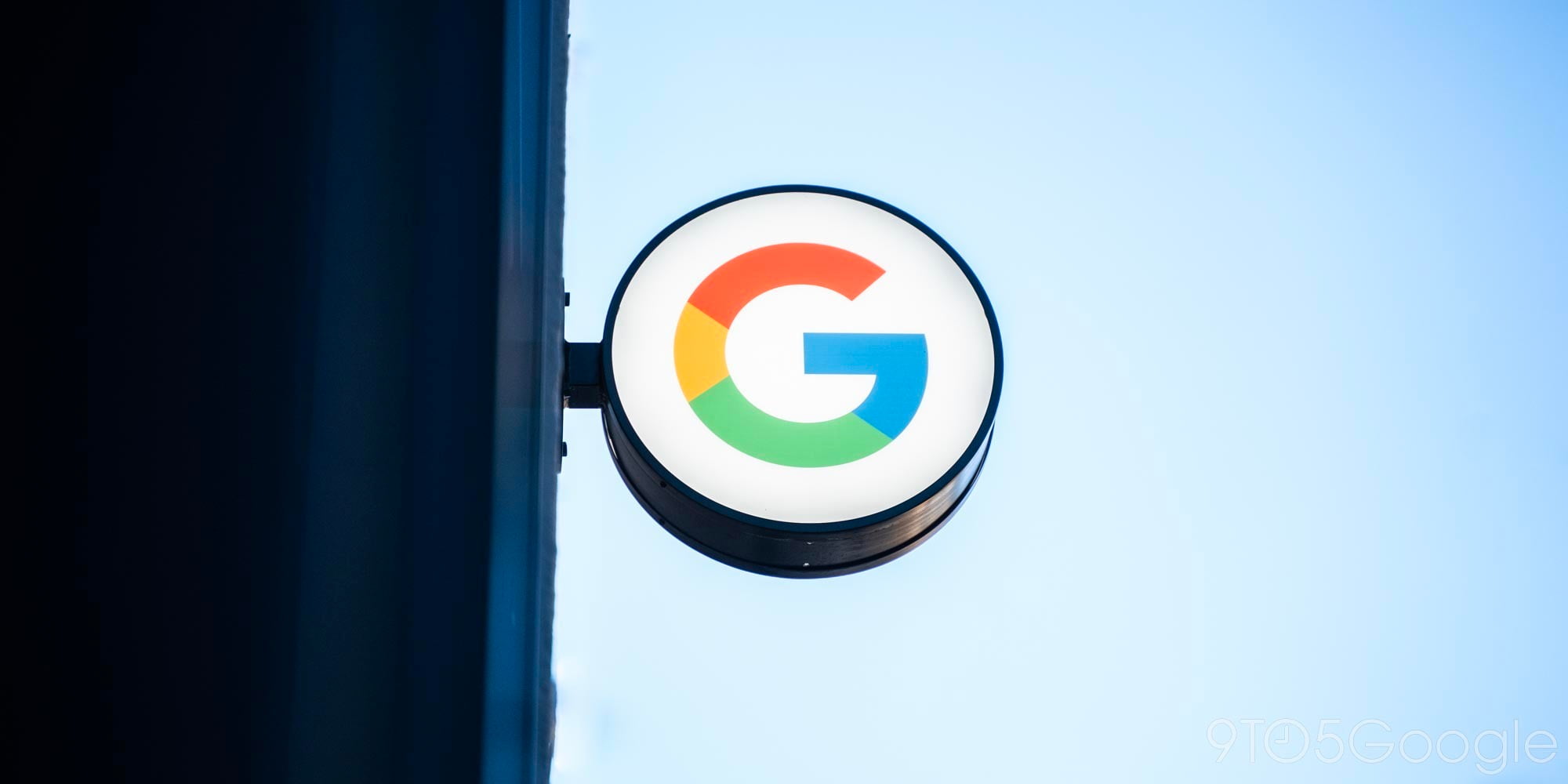

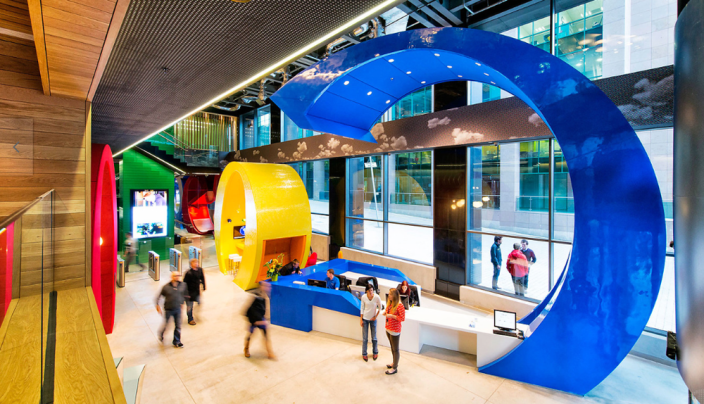
Photo: dexigner.com
In a surprisingly low-key response to a European court decision that individuals can require Google to remove links to sensitive information, executive chairman Eric Schmidt said that the court had got the balance wrong, and its chief legal officer say that the ruling was “disappointing” and “went too far,” reports the WSJ.
In response to a question at Google’s annual shareholder meeting, Schmidt said the case reflects “a collision between a right to be forgotten and a right to know.” A balance must be struck between those two objectives, Schmidt added and ”Google believes … that the balance that was struck was wrong.”
The European Union Court of Justice ruled that individuals could ask for the removal of links to information about them which was accurate where the passage of time made it “out-dated or irrelevant.”
Shareholders also raised concerns about the the controversial stock split that gave Google founders Larry Page and Sergey Brin 56 percent of the voting rights despite owning only 15 percent of the company.
Page said that the company’s goal is “making major investments in things that take a little longer to get done” and that by adding the new non-voting shares Google can avoid the “quarter to quarter focus” that he said plagues other public companies.
I have to admit sympathy with this view: too many public companies are forced by shareholders to focus on short-term financials rather than longer-term goals. Given Google’s record to date, it would be hard to argue that the co-founders are getting things too wrong …


In a filing with the SEC today, Google has revealed that it will be giving three of its top executives bonuses of more than $3 million. Co-founder and CEO Larry Page will not be awarded a bonus, nor will co-founder Sergey Brin. The two co-founders also take a salary of $1 a year, as their wealth is tied almost entirely into Google stock.
Chief Business Officer Nikesh Arora will be receiving a $3.5 million bonus, up from $2.8 million last year. Chief Legal Officer David C. Drummond will receive a bonus of $3 million, down slightly from the $3.3 million he was paid last year. Finally, Chief Financial Officer Patrick Pichette’s bonus increased to $3 million from $2.8 million.
Last month, Google announced that it had paid Eric Schmidt $6 million in cash and given him $100 million in restricted stock.
The bonuses issued to Arora, Drummond, and Pichette will be paid out on March 14th.


More than three years after Google founders Larry Page and Sergey Brin first proposed it, a controversial stock split has finally been scheduled for 2nd April after a shareholder lawsuit opposing the move was settled. The split will see the number of shares doubled and their value halved.
The controversy stemmed from the form the new shares will take. Google currently has two types of stock: Class A and Class B. Class A stock is what most shareholders own, and gives them normal voting rights. Class B stock, held by Page and Brin, gives them ten times the voting rights per share, which gives them 56 percent of the voting rights despite owning only 15 percent of the company.
The stock split will create a third type of share, Class C, which have no voting rights. This will enable the company to issue additional shares to reward employees without Page and Brin losing control of the company. Existing shareholders will get one Class C share for each Class A share they own. The lawsuit alleged that Class C shares would trade for less, and that their existing shareholding would therefore be reduced in value.
Under the terms of the settlement, Google has effectively agreed to make good any losses as a result of a gap opening up between the values of A and C shares, with up to $7.5 billion set aside. Class C shares will trade under Google’s existing ticker code GOOG, while Class A shares will get a new code, GOOGL.
Via Mercury News


[youtube=http://www.youtube.com/watch?v=98BIu9dpwHU]
Amazon CEO Jeff Bezos shocked Charlie Rose on Cyber Monday Eve (great timing for the PR-savvy retail giant) by showing him the future of delivery services – autonomous drones that will pick up and deliver wares from fulfillment centers. From which we can conclude that Charlie Rose doesn’t read 9to5Google, where the concept is old news.
We mentioned way back in February that Google was already working on drone delivery services:
Along with Glass, Google will have an opportunity to demonstrate other upcoming and Google X projects like driverless cars and mini-drone delivery systems at its stores.
We reference it again when the company launched the trial of its ‘Google Shopping Express’ same-day delivery service to Bay Area residents:
Google, in the long run, plans to use self-driving cars and flying drones as means of delivery.
9to5Google also heard this service was coming, and we have some more somewhat wild information on the program. Google, in the long run, plans to use self-driving cars and flying drones as means of delivery. We also heard Google’s delivery project came from the Google X incubator headed by cofounder Sergey Brin.
Clearly there are a lot of hurdles to jump on the way to this vision (privacy, theft, accidents, visual pollution, etc, etc). but it’s equally clear that these two Silicon Valley heavy-weights are prepping to battle in the skies above.
Google might have gotten there first, but Amazon definitely wins the PR battle so far: a short concept video for a service which doesn’t yet exist, and which even optimistically it doesn’t expect to launch for a couple of years, got everyone talking about them. Including Charlie Rose. Video below …

Hugo Barra, Google’s former VP of Android product development, says his move to Xiaomi was planned long before it emerged that Sergey Brin was romantically involved with his former girlfriend.
In an interview with AllThingsD, Barra said that the opportunity to play a key role in the global expansion of the company dubbed ‘the Apple of China’ was one he could not resist.
“To me, right away, it was a once-in-a-lifetime opportunity, truly a dream job, this idea of building a global company which could be as significant as Google from the ground up,” said Barra. “It was just something that I will never come across, with a team whom I know, with a company that has DNA similar to my own and, on top of that, to live in Asia for at least some period of time” …
Expand
Expanding
Close

According to a new report from AllThingsD, citing “sources in position to know”, one of Google’s top Android executives is leaving the company. The report states that Hugo Barra, who was the vice president of product management for Android, will soon be departing the company to join Chinese phone maker Xiaomi. Xiaomi produces its own high-end Android-based devices, though with a heavy custom skin on top. Barra originally joined Google in 2008 as a group product manager, having previously worked for speech firm Nuance, and has moved up the totem pole since then.
Xiaomi welcomes Hugo Barra and looks forward to him being a part of our ever-growing and talented team!
— Xiaomi (@Xiaomi) August 29, 2013
Hugo will be responsible for Xiaomi’s international business development and Android strategic partnerships.Welcome and let's do sth big!
— Xiaomi (@Xiaomi) August 29, 2013
This news comes on the heels of Andy Rubin, the creator Android, stepping down from his position earlier this year. Given that Android is Google’s top product right now, Barra’s decision, especially when coupled with Rubin’s departure, will undoubtedly cause some tension within the company. Barra often appeared on stage at Google events, most recently at the second-generation Nexus 7 unveil.
AllThingsD also says that Barra tendered his resignation only recently, but that it was before he ended a romantic relationship with another Google employe. It is now believed that Sergey Brin, who recently split from his wife, is currently involved with Barra’s ex. Sticky.
Update: Barra’s G+ statement:
A new Android chapter
After nearly 5½ years at Google and almost 3 years as a member of the Android team — the most amazing group of people I’ve ever worked with in my life — I have decided to start a new career chapter.
In a few weeks, I’ll be joining the Xiaomi team in China to help them expand their incredible product portfolio and business globally — as Vice President, Xiaomi Global. I’m really looking forward to this new challenge, and am particularly excited about the opportunity to continue to help drive the Android ecosystem.
It has been an amazing ride and true honor to be part of the Android team at Google, and I especially want to thank +Andy Rubin , +Hiroshi Lockheimer , +Sundar Pichai and +Vic Gundotra for their phenomenal support and mentorship over the years.
+Android team, I will truly miss you all!
Congratulations to Hugo on his exciting new adventure. We’ll miss him at Google but we’re thrilled that he’s sticking with Android. Best wishes Hugo!


Bloomberg published a nice read this morning following a tour of Google’s secretive X lab and a chat with some of the employees that work there. In the story Bloomberg talks Google Glass development, driverless cars, and lesser known X projects, speaks with Mary Lou Jepsen who heads up the Google X Display Division, and provides some insight into how the whole thing got started.
Some of the real projects in Google X sound almost as outlandish. Makani Power’s newest airborne turbine prototype, called Wing 7, is a 26-foot-long carbon-fiber contraption with four electricity-generating propellers that flies in circles at altitudes of 800 to 2,000 feet, sending power down a lightweight tether to a base station. “If we’re successful, we can get rid of a huge part of the fossil fuels we use,” says Damon Vander Lind, the startup’s chief engineer. Vander Lind acknowledges it might not work, but: “If you don’t take that chance, and put a decade of your life trying to do it, no progress will get made.”
Then there’s X’s still-secret project to bring Internet access to undeveloped parts of the world. A decade ago, David Grace, a senior research fellow at the University of York, spearheaded a project to mount broadband transmitters on high-altitude balloons, as part of a multicountry initiative backed by the European Commission, called the Capanina Consortium. The initiative never progressed beyond the experimental stage. Grace now says that he has heard that Google is working on such balloon-based broadband technology.

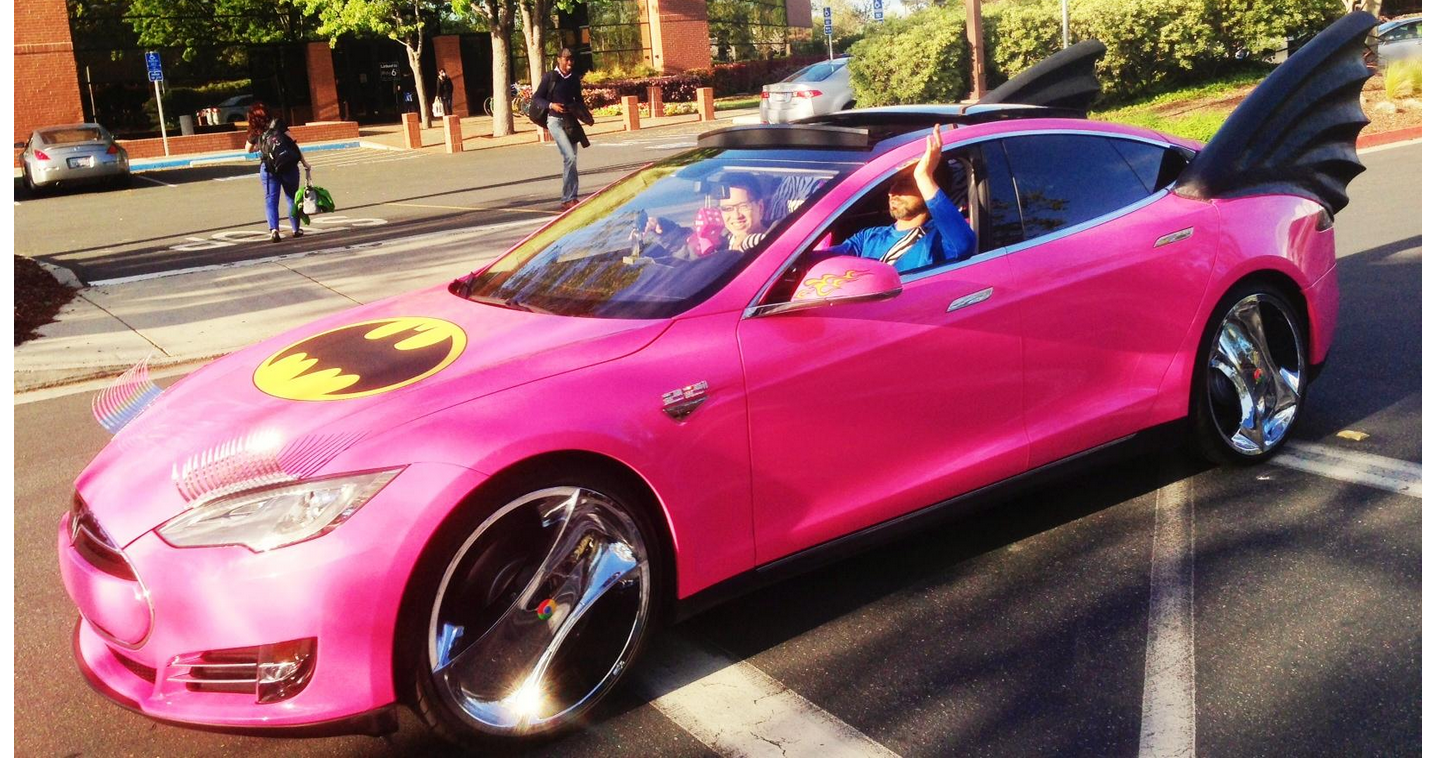
(Googlers turned Sergey Brin’s Tesla Model S into a pink Batmobile for April Fool’s Day)
According to a report from Bloomberg, Tesla’s Elon Musk has discussed with Google the possibility of adding self driving vehicle technology to its fleet of all-electric cars. The problem, says Musk, is that Google’s approach to the technology is currently too expensive compared to camera-based systems:
“The problem with Google’s current approach is that the sensor system is too expensive,” Musk said. “It’s better to have an optical system, basically cameras with software that is able to figure out what’s going on just by looking at things… “We’ve had some technical discussions with Google” about its Light Detection and Ranging, or Lidar, laser tracking system, Musk said last week, noting that it’s an expensive approach that may not prove feasible, Musk said.
Am a fan of Larry, Sergey & Google in general, but self-driving cars comments to Bloomberg were just off-the-cuff. No big announcement here
— Elon Musk (@elonmusk) May 7, 2013
While it’s possible Google could contribute to bringing the driverless features to future Tesla vehicles, Musk told Bloomberg it’s more likely the company will develop its own “autopilot system”. That’s something that other automakers are already doing with Toyota, Lexus, and Audi all showing off self-driving car technology at CES back in January:
Expand
Expanding
Close

Google’s Nathan Johns posted a picture of an all-pink Tesla Model S yesterday complete with the official bat signal on its hood, bat wings as a spoiler, and Chrome’s logo embedded in the middle of its alloys.
This candy-coated Tesla apparently belongs to Google cofounder Sergey Brin. According to Search Engine Round Table, Brin’s beloved and spirited Googlers played an elaborate April Fool’s Day prank last Monday and transformed his zero-emissions car into a cute flashy Batmobile.
Brin—seen driving his Tesla around LinkedIn’s headquarters in the image above (via Brian Li)—is sometimes called “Batman” around Google because of his Batcave-like Google X repository.

IEEE’s Rod Furlan just explained how he built his own Google Glass-like prototype.
Google’s Sergey Brin revealed at the 2012 Google I/O Developers Conference in June that a pair of beta, or “Explorer Edition”, Google Glasses cost $1,500 and would start shipping to I/O attendees in 2013, but Lee realized the components to such a headset display must be readily available if Google was able to start developing one. And so, he decided to build his own—admittedly rough—version.
After promptly selecting the Myvu head-mounted video display, Lee tried to find an onboard computer:
I settled on a fourth-generation iPod Touch. I had to “jailbreak” it, which eliminates limitations built into the iOS software by Apple. Once that was done, I could mirror the Touch’s main display to the microdisplay using its composite video output. This choice of onboard computer meant that for a point-of-view camera (used to record images and video), I needed one that could communicate via the iPod Touch’s Wi-Fi or Bluetooth wireless interfaces. I used a Looxcie Bluetooth camera, which is small enough to be mounted on the side of the frame once you strip it from its plastic shell; you can order it online for around $150. (I’m already building a second iteration of my prototype around a Raspberry Pi. This will allow more control over the camera than is currently possible with the iOS apps that work with the Looxcie and better integration of sensors such as accelerometers.)
Lee tested the prototype once the assembly process was over, and he noted his world immediately changed forever:
My world changed the day I first wore my prototype. At first there was disappointment—my software was rudimentary, and the video cable running down to the onboard computer was a compromise I wasn’t particularly pleased with. Then there was discomfort, as I felt overwhelmed while trying to hold a conversation as information from the Internet (notifications, server statuses, stock prices, and messages) was streamed to me through the microdisplay. But when the batteries drained a few hours later and I took the prototype off, I had a feeling of loss. It was as if one of my senses had been taken away from me, which was something I certainly didn’t anticipate.
Lee continued to give insight into how Google Glass and his iOS prototype could provide immense value. Unfortunately, he only corroborated his post with a few illustrations and no images. Go to IEEE for more details.
This article is cross-posted on 9to5Mac.

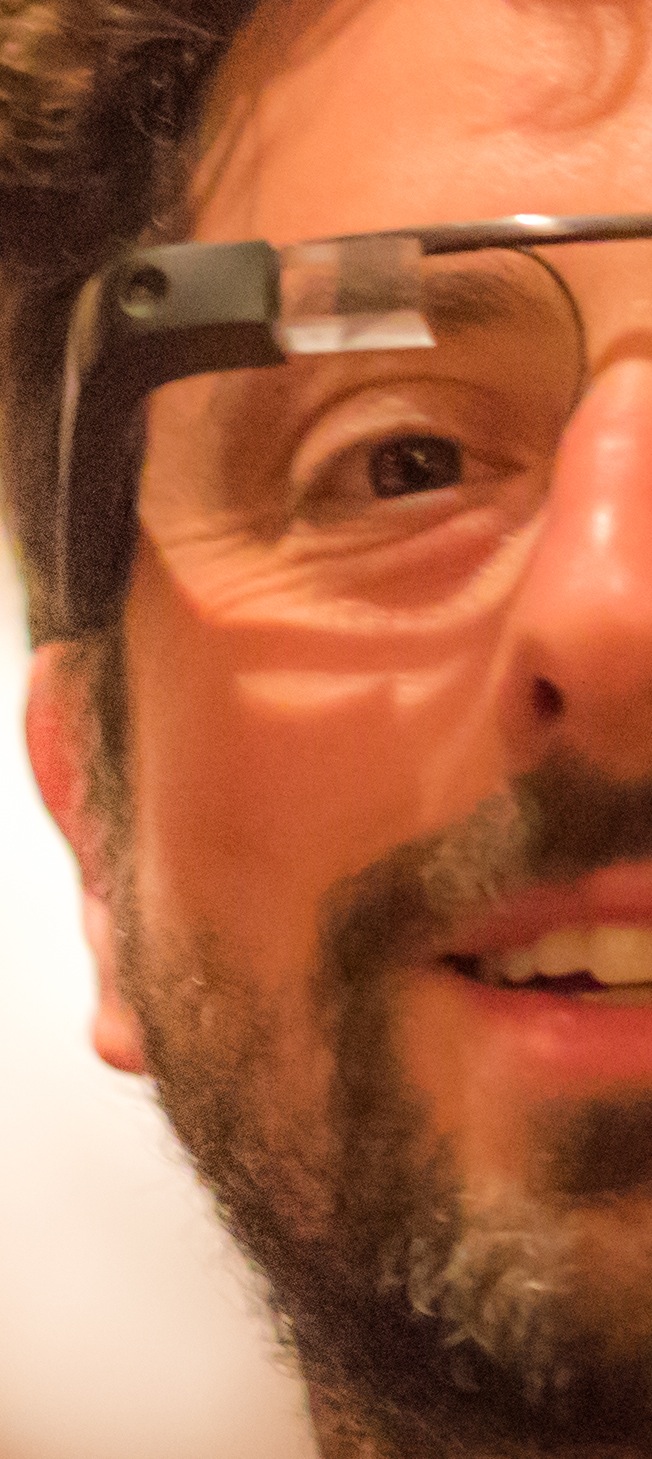
Late last night, Google’s Sergey Brin took to his Google+ account to post his thoughts on the eve of the U.S. elections and offer a plea to the winner. Brin explained he is “dreading today’s elections,” while describing government as “a giant bonfire of partisanship”:
I must confess, I am dreading today’s elections…Not because of who might win or lose…Not because as a Californian, my vote for President will count 1/3 as much as an Alaskan (actually it won’t matter at all — I’m not in a swing state)…Not because my vote for Senate will count 1/50 as much as an Alaskan…But because no matter what the outcome, our government will still be a giant bonfire of partisanship
His request for the winner? Withdraw from any political party and govern independently:
Expand
Expanding
Close

[youtube=http://www.youtube.com/watch?v=XNhyt107c88]
Update: During a Q&A following the signing of Google’s autonomous car bill today, Sergey Brin was asked how long until the public would be using the vehicles. While noting he plans for a broader subset of employees to test the vehicles in the near future, Brin noted he expects the public to begin using the vehicles within 5 years. Sergey also noted the company has had conversations with many car manufacturers but Google doesn’t currently have plans to build cars itself.
“Self driving cars do not run red lights” -Sergey
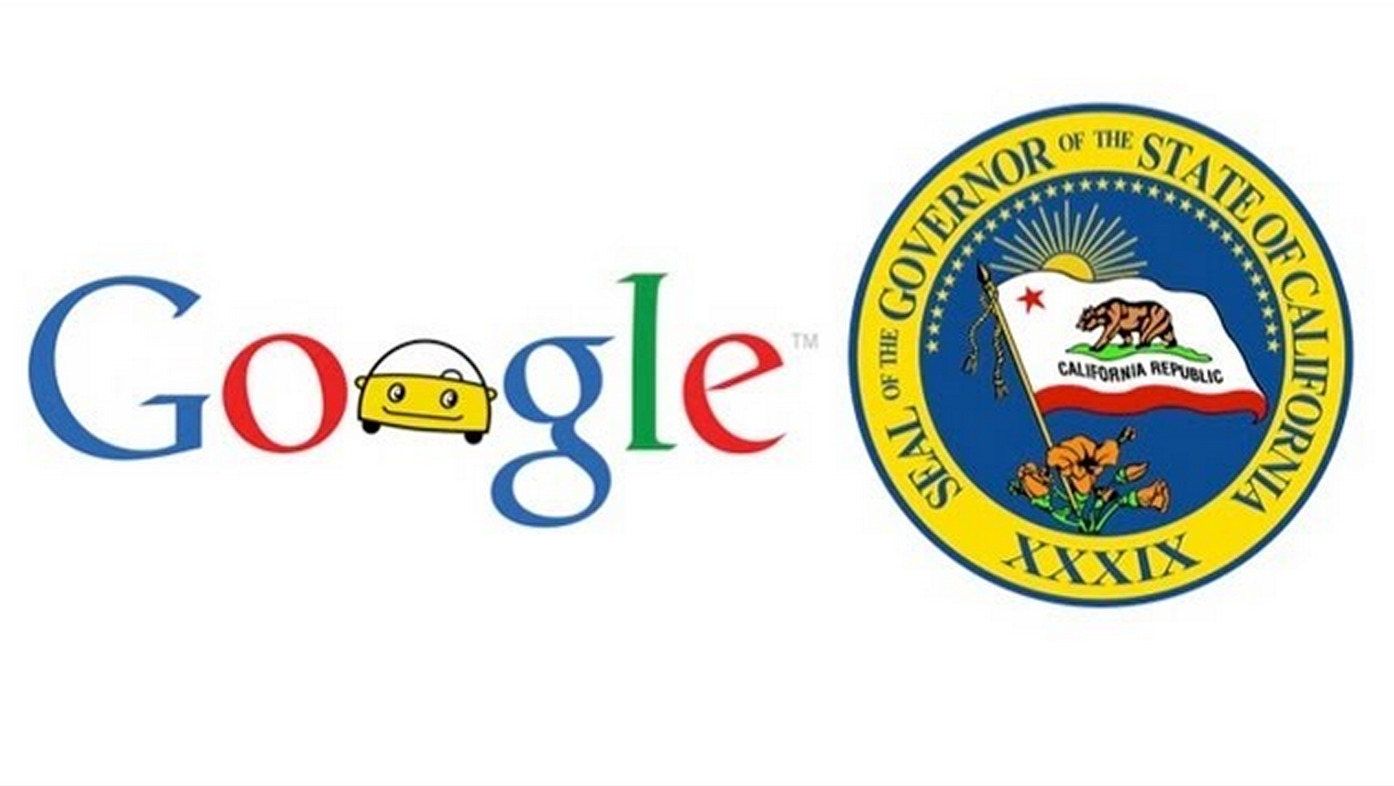
In a tweet from the Google Public Policy Twitter account, Google noted today that California Gov. Jerry Brown will be signing its autonomous vehicle bill supporting Google’s effort to bring its self-driving cars to public roads. Google will be streaming the signing at 1pm PT on the Google YouTube Channel (embedded above).
[tweet https://twitter.com/googlepubpolicy/status/250636721073557504]
The Bay Citizen reports Google is now only awaiting approval from Gov. Jerry Brown as its driverless car bill passed 37-0 in the Senate and 74-2 in the Assembly. The bill, which was put together by legislative staffer Howard Posner and sponsored by state Sen. Alex Padilla, would allow Google and other companies to test their driverless cars on public roads and require new laws governing the operation of the vehicles in public:
Padilla’s bill, SB 1298, would allow companies to test self-driven cars on public roads and require the DMV to draft rules governing use of the vehicles by the public. The measure also would define a car’s “operator” as the person sitting in the driver’s seat, or if there’s no one in the driver’s seat, the person who “causes the autonomous technology to engage.”… In its final form, the bill would give the DMV authority to reject the use of driverless cars that did not meet its standards. The measure also would require that owners be notified about what data their car is collecting, but it did not resolve questions of liability.
Google provided a statement to The Bay Citizen in an email:
Expand
Expanding
Close

The Wall Street Journal published a report with some new information on the interface for the Google Glasses:
In all, the glasses are like a wearable smartphone, allowing the user to take pictures, send messages and perform other functions via voice-activated commands. For instance, say “OK, Glass” into one of the glasses’ two microphones and a menu pops off to the side of your vision showing icons that will let you take a picture, record a video, use Google Maps or make a phone call.
After 10 minutes of playing with the glasses—which the company prefers to call Google Glass, since they don’t have lenses—I could see their long-term potential. The device fit well. It was easy to snap a picture or video without taking my smartphone out of my pocket. It was cool to see the information there in front of my right eye, though a little disorienting. I kept closing my left eye, which was uncomfortable.
Mr. Brin said his favorite feature is the time-lapse capability that lets him snap photos of his kids every 10 seconds when he is playing with them. “I never think about taking out my phone,” he said. “That would really be disruptive to my play time.”
“I have always disliked the feeling that with technology I am spending a lot of my time and attention managing it,” added Mr. Brin, dressed casually in a white T-shirt and jeans. “The notion of seamlessly having access to your digital world without disrupting the real world is very important.”
The reporter used the glasses at the DVF Fashion show in New York City this week (Gallery). It sounds like the interface options are progressing since I wore the headset briefly at Google I/O in June. However, we are still a long way from a usable product.

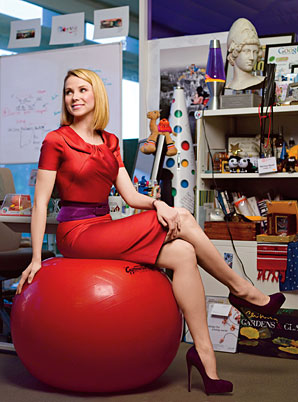 The NYTimes has the story:
The NYTimes has the story:
- The appointment of Ms. Mayer, who was employee No. 20 at Google and was one of the few public faces of the company, is considered a surprising coup for Yahoo, which has struggled in recent years to attract top flight talent in its battle with competitors like Google and Facebook.
- Ms. Mayer, 37, had for years been responsible for the look and feel of Google’s most popular products: the famously unadorned white search homepage, Gmail, Google News and Google Images. More recently, Ms. Mayer, an engineer by training whose first job at Google included computer programming, was put in charge of the company’s location and local services, including Google Maps, overseeing more than 1,000 product managers. She also sat on Google’s operating committee, part of a small circle of senior executives who had the ear of Google’s co-founders, Larry Page and Sergey Brin.
Mayer has been on the outs for some time at Google, and she did not show for Google I/O this year. She moved up the food chain from being Google employee No. 20 and first female engineer. Mayer’s rise took her from engineer to project manager to Director of Consumer Web Services to VP of Search Products and User Experience, and finally to Location in a broad shift. She was also on the very influential “Operating Committee” of high ranking officers.
However, she was not promoted as one of Larry Page’s seven business heads when he re-took over the company last year.
[tweet https://twitter.com/marissamayer/status/224968460139114496]
Mayer is on Walmart’s board of directors, and she briefly dated Google CEO Page who said:
“Since arriving at Google just over 13 years ago as employee #20, Marissa has been a tireless champion of our users. She contributed to the development of our Search, Geo, and Local products. We will miss her talents at Google.”
Mayer said,
“I am honored and delighted to lead Yahoo!, one of the internet’s premier destinations for more than 700 million users. I look forward to working with the Company’s dedicated employees to bring innovative products, content, and personalized experiences to users and advertisers all around the world.”
The press release is below.

[youtube=http://www.youtube.com/watch?v=VuC0i4xTyrI]
You already saw a replay of the skydiving stunt if you watched today, but here is the rest.
Expand
Expanding
Close

[tweet https://twitter.com/stroughtonsmith/status/217751034037141505]
Twitter is abuzz with folks spotting Sergey Brin donning a pair of Google Glasses at Google I/O this morning. There are no pictures of the Google co-founder with the headset yet—but stay tuned.
The 2012 Google I/O Developers Conference starts today at the Moscone Center West in San Francisco, Calif., with events continuing until June 29 at 4:30 p.m. PST.

[youtube=http://www.youtube.com/watch?v=8oPRJh3eCjA&feature=youtube_gdata]
The U.S. Patent and Trademark Office just granted Project Glass a patent that protects the trackpad feature of Google Glasses.
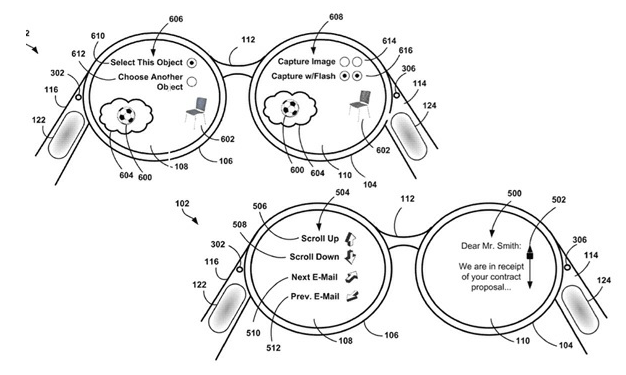 Google co-founder Sergey Brin appeared with his wife, Anne Wojcicki, on California Lieutenant Governor Gavin Newsom’s Current TV show last month to briefly let the politician demo a pair of Google Glasses. During “The Gavin Newsom Show” interview (above), Brin gave the world a glimpse as to how the space-age spectacles work.
Google co-founder Sergey Brin appeared with his wife, Anne Wojcicki, on California Lieutenant Governor Gavin Newsom’s Current TV show last month to briefly let the politician demo a pair of Google Glasses. During “The Gavin Newsom Show” interview (above), Brin gave the world a glimpse as to how the space-age spectacles work.
Viewers immediately noticed a trackpad-like control on the right side of the augmented-reality glasses, but the USPTO just protected the feature by granting Project Glass a patent for the trackpad. The patent covers a sensor device, for either side, that tracks gestures and finely controls the heads-up display. The Mountain View, Calif.-based Company also detailed several gestures that work with the trackpad—such as scrolling, tapping, or flipping—to provide visible, semi-transparent options.

Google’s Sergey Brin and Larry Page have sported a pair of Google Glasses while appearing on just about every major talk show/news outlet across the country at this point, but the company’s cofounders seem to do a lot of talking and not much showing.
However, Brin finally took the first step and let a non-Googler experience the augmented reality handset last week. He appeared with his wife, Anne Wojcicki, on California Lieutenant Governor Gavin Newsom’s Current TV show on May 23 and briefly let the politician in on the secret. A video of the interview is above.
“You can easily forget you have them on, and sense the capacity of use in the future,” Newsom later told Wired, while detailing how the headset felt “incredibly light, comfortable and inconspicuous” on his head.
During his demonstration on “The Gavin Newsom Show,” Brin subsequently gave the world a glimpse as to how the space-age spectacles work. According to Wired:
In the video, Brin navigates the system via a touchpad on the right side of the headset behind the display. He slides his finger forward and back to locate a photo he took of Gavin Newsom with the contraption. He then places the headset on Newsom’s face, and continues to navigate until the photo is located. […] After returning the glasses to his own face, Brin swiped down on the touchpad of the glasses and continued the interview. The down-swipe could possibly be used to exit the photo album he was demoing to Newsom. Whatever the case, Brin’s swipes answer questions about how the interface is navigated.

Google just got its hands on four more Project Glass-based patents this morning.
As discovered by Engadget, the U.S. Patent and Trademark Office granted patents this morning that detail the majority of Google Glasses’ right-side. The eye-hovering camera and its inner-workings hidden within the spectacle rim were successfully patented, as well as the nose-bridge sensor, and the function for illustrating sounds in the heads-up display with source, direction, and range details. The Mountain View, Calif.-based Company also got the rights to use both eye spectacles as separate displays. The patent’s included example, as shown above, depicts a map visible in one eye with navigation particulars streaming to the other eye.
Just last week, patents published by the USPTO showed Google successfully patented at least the ornamental design of its augmented reality glasses that were unveiled last month. The patents show a device that does not look exactly like the prototypes revealed in the concept videos, nor the pair worn by Sergey Brin, but most designs get altered before hitting the stores’ shelves anyway.
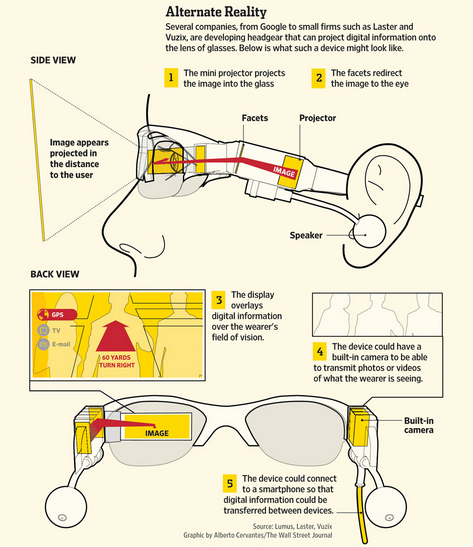 Meanwhile, in related news, according to the Wall Street Journal, eyeglasses designer Michael Pachleitner Group is jumping on the bandwagon by integrating technology to display information and imagery on to spectacles in its workforce. The Austrian company recently dressed its warehouse employees with $13,000 frames built by Knapp AG.
Meanwhile, in related news, according to the Wall Street Journal, eyeglasses designer Michael Pachleitner Group is jumping on the bandwagon by integrating technology to display information and imagery on to spectacles in its workforce. The Austrian company recently dressed its warehouse employees with $13,000 frames built by Knapp AG.
The devices provide visual details through a Wi-Fi connection, so warehouse workers can access over 1.4 million items stored in the facility. The eyewear company hopes to staff all six warehouses by July with employees who will wear the costly apparatus all day. The measure aims to cut “picking errors” by an estimated 60 percent.

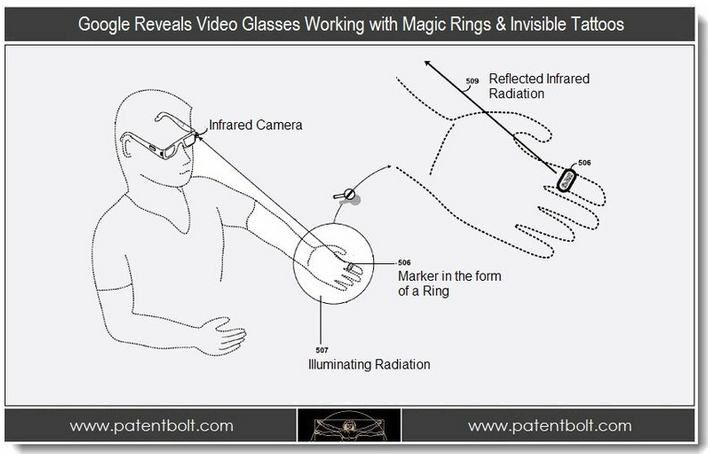
At this point, at the very least, we already know that Google’s augmented reality glasses are capable of snapping a photo. However, we do not have much of an idea of how the UI might work other than what is in the initial concept video. Our sources previously indicated that Google was using a “head tilting-to scroll and click” for navigation of the user interface. Today, we get a look out how the company is experimenting with alternative methods of input for the glasses from a patent recently granted by the United States Patent & Trademark Office and detailed by PatentBolt.
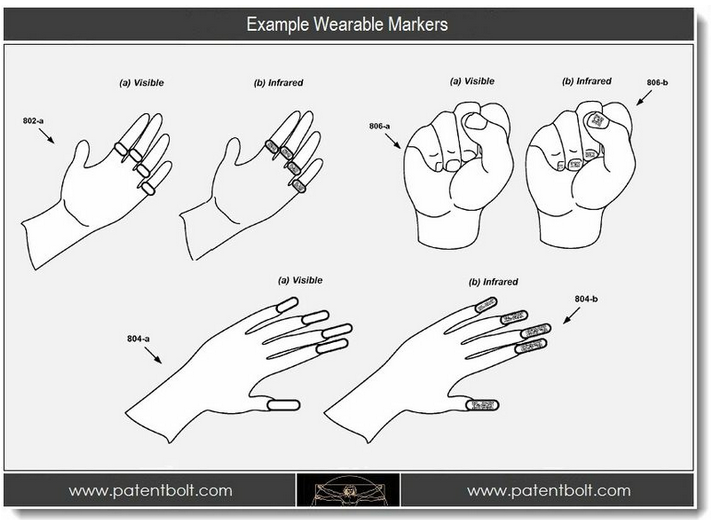 According to the report, the highlight of the patent is how Google’s glasses could work with hand gestures. The patent described various hand-wearable markers, such as a ring, invisible tattoo, or a woman’s fingernail, which could be detected by the glasses’ IR camera, to “track position and motion of the hand-wearable item within a FOV of the HMD.” In other words, the wearable marker, in whatever form factor, would allow the glasses to pick up hand gestures. The report also noted multiple markers could be used to perform complex gestures involving several fingers or both hands:
According to the report, the highlight of the patent is how Google’s glasses could work with hand gestures. The patent described various hand-wearable markers, such as a ring, invisible tattoo, or a woman’s fingernail, which could be detected by the glasses’ IR camera, to “track position and motion of the hand-wearable item within a FOV of the HMD.” In other words, the wearable marker, in whatever form factor, would allow the glasses to pick up hand gestures. The report also noted multiple markers could be used to perform complex gestures involving several fingers or both hands:
Expand
Expanding
Close

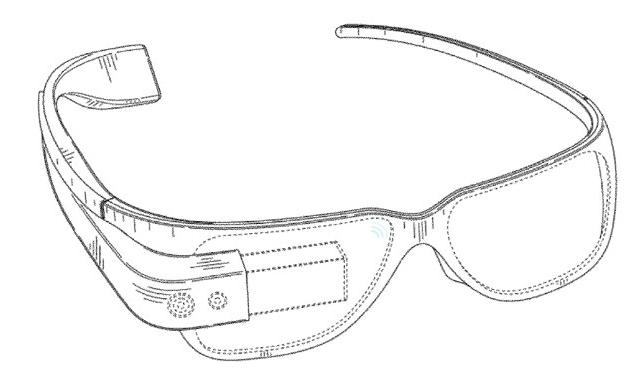
Patents recently published by the United States Patent & Trademark Office (via Engadget) show Google successfully patented at least the ornamental design of its “Project Glass” augmented reality glasses unveiled last month. It does not look exactly like the prototypes shown off in the concept videos, nor the pair worn by Sergey Brin, but we expect the design will be altered somewhat before it eventually hits the market.
Expand
Expanding
Close

Google just announced, well, boasted, about its involvement with the 2012 World Wide Web conference that occurred last month.
Vice President of Engineering Prabhakar Raghavan took to the Official Google Research Blog this afternoon to detail the search engine’s role in the widely popular and annual series. Google was a major supporter of the conference and even sponsored it, coupled with many Googlers having taken an active role through keynotes and papers.
“More than forty members of Google’s technical staff gathered in Lyon, France in April to participate in the global dialogue around the state of the web at the World Wide Web conference (WWW) 2012,” explained Raghavan. “A decade ago, Larry Page and Sergey Brin applied their research to an information retrieval problem and their work—presented at WWW in 1998—led to the invention of today’s most popular search engine.
The new VP further said Mobile Web in the technical program is becoming more apparent as the conference has “evolve[d] over the years,” and then he noted the WWW community is transitioning from a “classic ‘bag of words’ of web pages” to an “entity-centric view.”
Raghavan is Yahoo’s former chief scientist, but 9to5Google reported that he left the position in March to take an executive job at Google amid massive cuts at the Sunnyvale, Calif.-based search engine.
A list of Googlers and their conference contributions is below:


A recent interview with Google’s cofounder Sergey Brin received a lot of attention due to his view that Apple and Facebook are the biggest threats to the open Internet. While Brin still recommends reading the full article here, he posted a note on his Google+ account today to clarify some thoughts that he felt were “particularly distorted in the secondary coverage” of the interview.
In the post, Brin clarifies that on the issue of app ecosystems, which are not as open as the rest of the Web, he does not think the “issue is on a par with government based censorship.” He also took time to clarify his view of Apple and Facebook, noting he has “always admired Apple’s products,” especially while using an iMac to type his post. He also called Facebook “a key tool for political expression.” Brin’s full post is below:
Expand
Expanding
Close

Somebody (Thomas Hawk – Flickr) with a real camera was on the scene last night to capture Project Glass’ prototypes sitting on Google Co-founder Sergey Brin’s dome.
Another close-up is below (via The Verge).